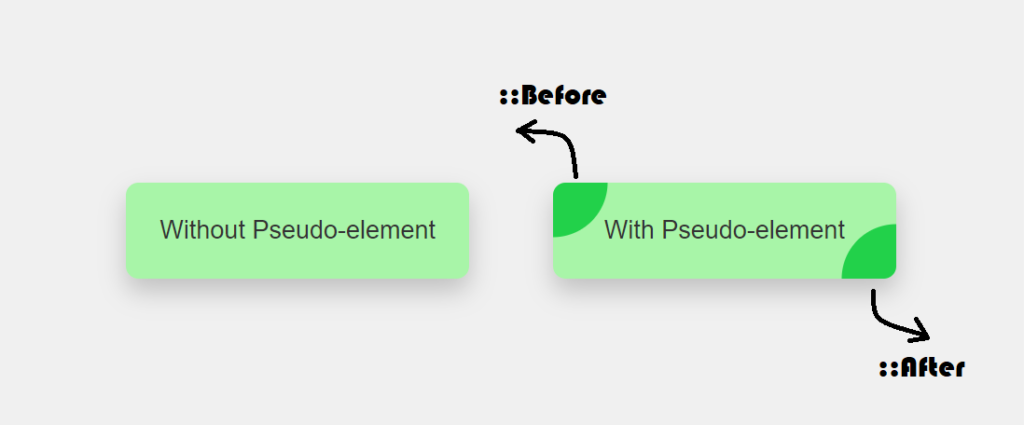Introduction:
Have you ever wondered how some websites create beautiful effects without using images or extra HTML code? This magic is often done with CSS pseudo-elements! In this guide, we’ll dive into what pseudo-elements are, how they work, and how you can use them to make your web pages look amazing. You will learn about different types of pseudo-elements like ::before, ::after, ::first-letter, and more. By the end, you’ll understand how to make your content stand out with simple CSS tricks.
1. What Are CSS Pseudo-Elements?
CSS pseudo-elements are special keywords added to selectors that allow you to style specific parts of an element. Unlike pseudo-classes, which target elements based on their state (like :hover or :focus), pseudo-elements create virtual elements within the content, allowing you to apply styles to parts of a document without changing the HTML structure.
For instance, you can use the ::before pseudo-element to insert content before an element’s main content, or ::first-letter to style just the first letter of a paragraph.

2. Common CSS Pseudo-Elements and Their Uses
a) ::before
The ::before pseudo-element allows you to insert content before the actual content of an element. It is often used for decorative purposes, such as adding icons or custom styling elements.
p::before {
content: "Note: ";
color: red;
}Example Description: This CSS adds the text “Note:” before every paragraph and styles it in red.
This is an important message that starts with a red “Note:” prefix.
b) ::after
Similar to ::before, the ::after pseudo-element inserts content after an element’s content. This is commonly used for adding stylistic flourishes like symbols or images.
p::after {
content: " - Read more";
color: blue;
}Example Description: This CSS adds ” – Read more” after every paragraph and styles it in blue.
This is an important message that Ends with a red “- Read more”.
c) ::marker
The ::marker pseudo-element targets the marker box of a list item, allowing you to style the bullets or numbers in an ordered or unordered list.
li::marker {
color: green;
font-size: 1.5em;
}Example Description: This CSS changes the color of list markers to green and makes them larger.
- First item
- Second item
- Third item
d) ::first-letter
The ::first-letter pseudo-element allows you to style the first letter of a block of text. This is often used for drop caps or to highlight the initial letter of a paragraph.
p::first-letter {
font-size: 2em;
font-weight: bold;
color: purple;
}Example Description: This CSS enlarges and colors the first letter of a paragraph in purple.
This is an example paragraph where the first letter is styled differently to stand out.
e) ::first-line
The ::first-line pseudo-element targets the first line of a block of text, allowing you to apply unique styling to it.
p::first-line {
font-weight: bold;
text-transform: uppercase;
}Example Description: This CSS makes the first line of each paragraph bold and uppercase.
This is an example paragraph where the first line is styled to be bold and transformed to uppercase. The effect will only apply to the text that fits on the first line.
f) ::selection
The ::selection pseudo-element allows you to style the portion of a document that the user has highlighted (selected) with their mouse or keyboard.
::selection {
background: yellow;
color: black;
}Example Description: This CSS changes the background color to yellow and text color to black when the user selects text.
Select any part of this text to see the custom selection styling. The background of the selected text will turn yellow, and the text color will be black.
3. How to Use CSS Pseudo-Elements: Practical Examples
Example 1: Creating Custom Bullets in Lists
By combining ::before and ::marker, you can create custom bullets for your lists.
li::before {
content: "★";
color: gold;
margin-right: 10px;
}Explanation: This CSS adds a gold star before each list item, replacing the standard bullet.
- First item
- Second item
- Third item
Example 2: Adding Decorative Content
Using ::after, you can add decorative content after headings to make them stand out.
h1::after {
content: "✨";
margin-left: 5px;
}Explanation: This CSS adds a sparkle emoji after every h1 heading.
Welcome to My Website
4. Comparing CSS Pseudo-Elements and Pseudo-Classes
Pseudo-Elements vs. Pseudo-Classes
While both pseudo-elements and pseudo-classes are used to style elements based on conditions, they serve different purposes. Pseudo-classes apply styles based on an element’s state or position in the document, while pseudo-elements allow you to style specific parts of an element or add content without modifying the HTML.
| Pseudo-Elements | Pseudo-Classes |
|---|---|
| Style specific parts of elements | Style elements based on state |
| Create virtual elements | React to user interactions |
Examples: ::before, ::after | Examples: :hover, :active |
Placeholder for Image: A side-by-side comparison image showing the differences between pseudo-elements and pseudo-classes.
5. Comprehensive Table of CSS Pseudo-Elements
| Selector | Example | Example Description |
|---|---|---|
::before | p::before | Inserts content before a paragraph |
::after | p::after | Inserts content after a paragraph |
::marker | li::marker | Styles the marker (bullet/number) of list items |
::first-letter | p::first-letter | Styles the first letter of a paragraph |
::first-line | p::first-line | Styles the first line of a paragraph |
::selection | ::selection | Styles the selected/highlighted text by the user |
Conclusion
CSS pseudo-elements are incredibly useful tools that allow you to add style and content to your web pages without needing to change the HTML. By understanding and applying pseudo-elements like ::before, ::after, and ::first-letter, you can create visually engaging and unique designs that enhance the user experience.
Now that you have a solid understanding of pseudo-elements, try experimenting with them in your own projects. The possibilities are endless!

